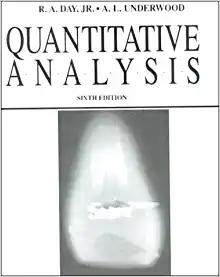Selection of optimal sample size for titration
Correct selection of sample size and titrant concentration can minimalize titration errors.
Part of the problem is discussed at the end point detection page. In short - too low concentration of sample and too low concentration of titrant mean that the steep part of the curve is short, which makes selection of the end point indicators difficult. But that's not all.
When discussing titration accuracy we should also take into account how precisely we can measure volume of the sample and volume of the titrant added. In most cases we will end titration somewhere between graduation marks. We can't estimate volume with better accuracy than about one fourth of the distance between graduation marks. That means 0.025 mL for a typical 50 mL burette. If we use 1 mL of the titrant, 0.025 mL means relative error of 2.5%. If we use 50 mL of the titrant, relative error goes down to 0.05%. The same can be said about relative error being effect of the burette tolerance - A class 50 mL burette has a tolerance of 0.05 mL (see volumetric glassware section). If we use 1 mL of the titrant that means 5% relative error, if we use 50 mL of the titrant, that means 0.1% relative error. Diference is huge and conclusion is obvious - we should use as large volume of titrant as possible.
Measurement of the sample volume is easier, as we will usually use single volume pipette. Still, relative error in the case of A class 5 mL pipette is 0.2% (±0.010 vs 5 mL), while relative error of 25 mL pipette is 0.12% (±0.030 vs 25 mL). Difference is not that large, but obviously larger pipette has lower relative error.
We don't want to be forced to refill burette, as that always mean more measurements and more occasions to increase the error. Thus we should try to design our experiment in such a way, that the amount of titrant used will be around 70%-90% (or even 80%-90%) of the burette volume - this means low relative error and still some margin in the case we need a little bit more titrant than expected.
For example imagine we are asked to determine concentration of acetic acid in the commercialy sold white vinegar. Label reports that the solution is 5% in acetic acid. Let's assume we will be using 0.1M NaOH titrant - that is typical concentration of strong base used for titration. What volume of the vinegar should we take?
Let's start with the reaction equation:
CH3COOH + NaOH → CH3COONa + H2O
We want to use about 40 mL of titrant, that is 0.040×0.1=0.004 mole of NaOH (4 millimoles) - as sodium hydroxide reacts with acetic acid on the 1:1 basis we want to titrate about 4 millimoles of acetic acid. Acetic acid molar mass is almost exactly 60 g/mol, so 4 millimoles weigh 0.004×60=0.24 g. Label claims solution is 5%, that means we need 0.24/0.05=4.8 g of the solution. We won't make a huge mistake assuming solution density to be about 1 g/mL (in fact it is 1.0055 g/mL) - that in turn means we should start with about 4.8 mL of the acetic acid. We can round 4.8 mL up to 5 mL - volume of the titrant will be still below 50 mL and we can use 5 mL single volume pipette.
If we have no idea about the concentration there is not much we can do - but we can always start with some small sample and titrate it just to get some rough estimate of the concentration. At this stage even 10% error is not a problem, as it will still allow us to calculate optimal sample size.





